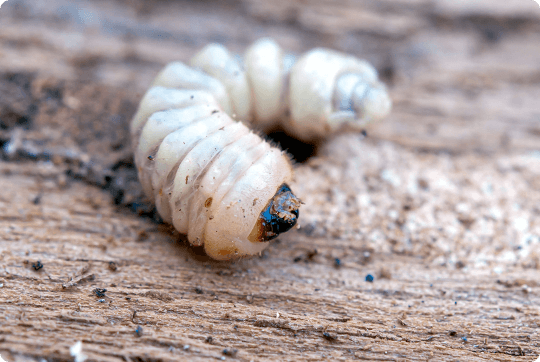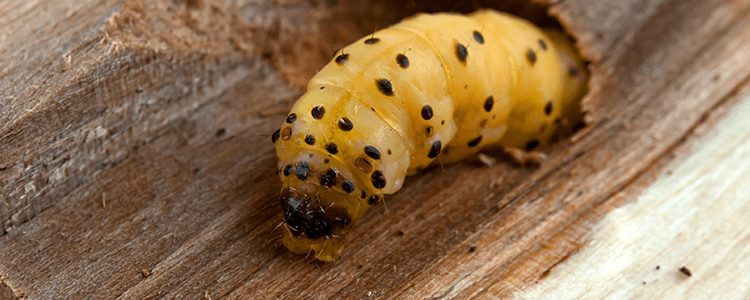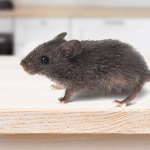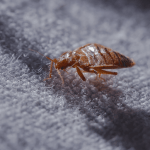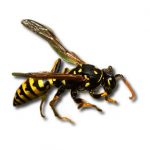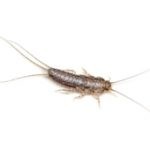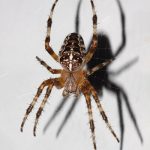Woodworm Life Cycle: From an Egg to a Wall-Scratching Beetle
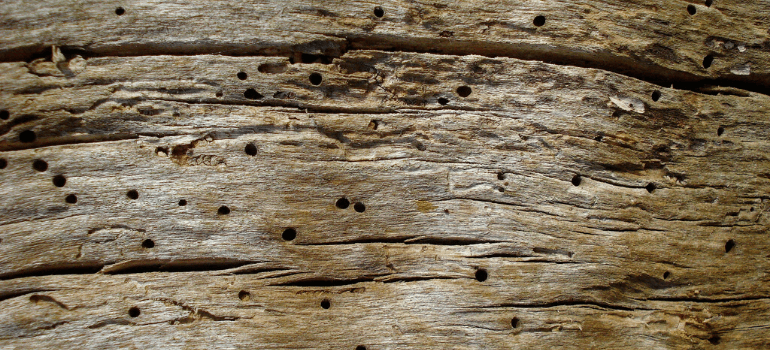
Woodworm is the larva of any wood-boring beetle. Despite the fact that they are not dangerous for human health, an infestation can cause serious problems in your property, as they feed on wood after they hatch. To treat the infestation more effectively, it is important to spot it in the early stages.
The life cycle of woodworms can be divided into 4 stages: hatching, feeding on wood and emergence as a beetle, mating, and laying more eggs. Adult beetles can be spotted around May and August. After some time, the adult species start mating, creating more woodworms to feed on timber.
Check also: Most Common Wood Boring Insects in the UK
Woodworm Eggs
At the beginning of its cycle, the female beetle searches for suitable conditions to lay eggs. The choice will most likely be dead timber with a lot of cracks or previously created holes, as it provides a safe spot for the egg to hatch. In normal conditions, the egg will hatch within 6 to 10 days.
Woodworm Larvae
The larval stage is the longest one in the woodworm’s lifecycle, as it goes on for up to 5 years. In their natural environment, it takes only a year for the species to develop fully.
However, in occupied buildings, woodworm larvae are not exposed to the same humidity and temperature levels as in the wild, hence, it requires more time to transform from a larva to an adult beetle. For that reason, you are more likely to find these insects in buildings with excess moisture.
After the eggs hatch, the feeding starts. The larvae continue to feed on timber, leaving 1-2 mm in diameter tunnels below the surface, which eventually cause damage to the wood structure.
Read more: How to Get Rid of Woodworm Infestation
Woodworm Pupae
At this point in its life, the woodworm will transform from a larva to an adult beetle. Moving closer to the timber surface, the larvae create so-called “pupal chambers” – expanded tunnels, that allow room for growth.
Once changed, the newly-transformed beetles push their way out of the timber. Usually, this stage is associated with the appearance of ‘frass’ or ‘bore dust around the wood. If you have noticed little holes and piles of dust near them, it can be a sign of an active woodworm infestation.
Wood-boring Beetle
As soon as the beetles leave their safe place, they search for a mating partner. Males have only 3 to 4 days to serve their sole purpose – successfully mate with as many females as possible. On the other hand, once out, female adult beetles have around 2 weeks to find a perfect spot for the new batch of eggs to grow. And that’s how the life cycle continues.
Frequently Asked Questions
If the surface of the wood has been coated with paint or wax, is it possible for the woodworm eggs to survive?
No, the woodworm eggs can’t survive on a painted surface. That’s why female beetles choose cracked surfaces, so the eggs will be hidden and safe.
Do female woodworm species choose old holes to lay eggs?
Yes, if there are any existing holes, most likely the beetles will choose them. However, if you have treated the timber previously with chemicals, the eggs will die.
Where are the woodworm beetles most likely to lay eggs?
So, the eggs are laid in batches of 30 to 60. They will spend between 10 to 30 days (depending on the species) in one place. To protect them, the female beetle will try to find a safe spot, which is most likely to be on old timber with a lot of cracks and holes. In order for the eggs to hatch, there should be a certain level of humidity; therefore, the beetles are more likely to appear in poorly ventilated areas like basements or subfloors.
How long do woodworms live?
From 10 to 14 days. However, the whole life cycle of the insect is quite lengthy. To develop from an egg to an adult beetle, it might take the insects from 2 to 5 years.
During which season do wormwood beetles emerge?
Around May and August. During this time of year, they are the most active. However, if they are fully developed, they can emerge at any time.
Conclusion
Hopefully, we helped you better understand the woodworm life cycle and how they emerge in the timber. It is important to understand that there are various types of woodworm beetles in the UK, therefore, the infestations might require different treatments. If you have spotted any of the signs of a woodworm infestation, don’t hesitate to take measures and contact a woodworm treatment specialist to resolve the issue as soon as possible!
Spotted wood-boring beetles in your furniture?
Note that we only aim to provide some useful information about how to identify woodworms in each stage of their life.



